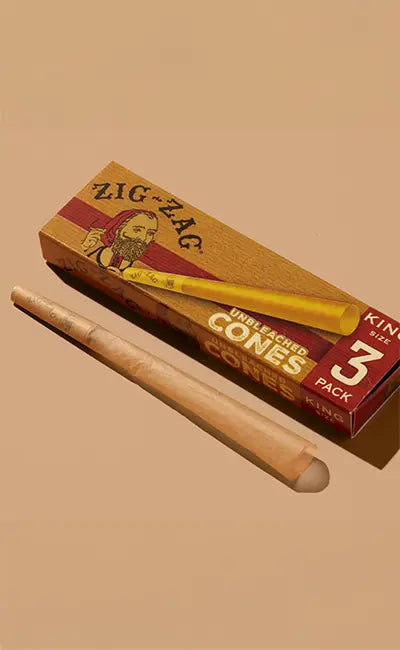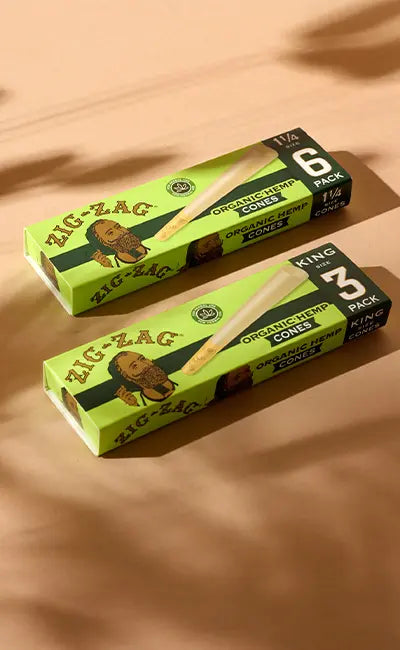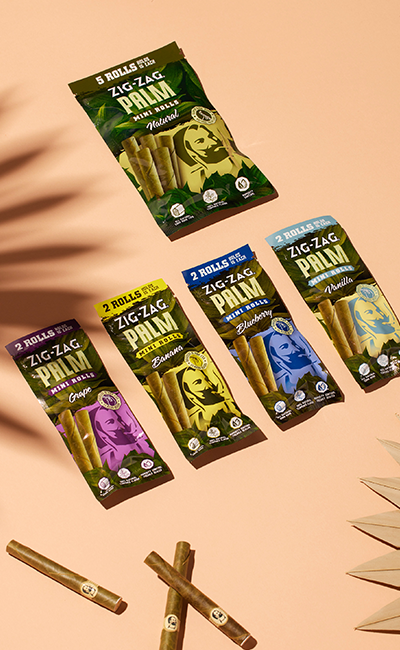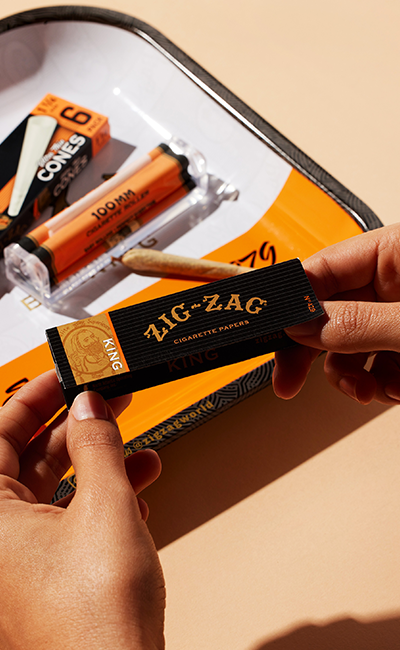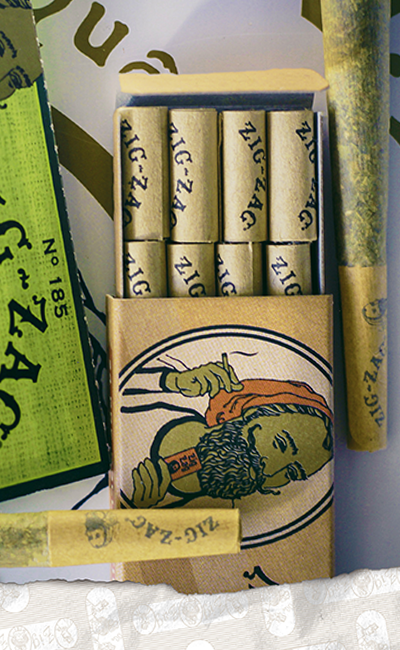The history of rolling paper types is as rich and varied as the cultures that have adopted them over the centuries. Initially, smoking was a luxury, confined to pipes and cigars, until the discovery and innovation of
rolling papers brought smoking to the masses. These thin sheets used for rolling tobacco and other substances have undergone a significant transformation, evolving from crude materials to the sophisticated and diverse options available today. This evolution reflects changes in smoking culture, with shifts towards personalization, convenience, and a growing awareness of health and environmental impacts. As we explore the
different types of rolling papers, it's fascinating to see how they've adapted to meet the needs and preferences of smokers worldwide, becoming an integral part of smoking culture.
Types of Rolling Paper Materials
Rice Rolling Papers
Rice rolling papers offer a unique combination of thinness and strength, making them a popular choice among smokers who prefer a cleaner, more subtle smoking experience. These papers are made from processed rice and sometimes a mixture of other fibers to increase their resilience. One of the key benefits of rice rolling papers is their low taste profile, which allows the natural flavors of the tobacco or herbs to shine through. Additionally, their thinness contributes to a slower burn, providing a longer and more enjoyable smoking session. Rice papers are also recognized for their lower ash production, resulting in cleaner smoke.
Hemp Rolling Papers
These rolling papers have gained popularity for their environmental benefits and distinctive smoking qualities. Made from the hemp plant, these papers are a renewable resource that requires less water and pesticides to grow. The benefits of
hemp rolling papers include their slow-burning properties, which extend the duration of the smoking experience. They also offer a slight natural flavor that can enhance the overall taste.
Flax Rolling Papers
Flax, a fiber derived from the linseed plant, is used to create papers that are strong yet thin. These characteristics ensure a consistent burn rate, preventing the paper from extinguishing too quickly or burning unevenly. Flax papers are appreciated for their neutral taste, which, like rice papers, does not interfere with the flavors of the smoke. Their smooth burn and reliability make them a preferred choice for smokers who value a straightforward, no-fuss smoking experience.
The Rise of Hemp Rolling Papers
Environmental Advantages of Hemp Papers
Hemp rolling papers are emerging as a sustainable alternative for smokers, offering a range of environmental advantages that underscore their eco-friendly appeal. This shift towards hemp-based products reflects a growing awareness and commitment to reducing the environmental impact of smoking paper types:
-
Fast Growth: Hemp is notably efficient in its growth, maturing in about 120 days. This rapid growth cycle enables hemp to be harvested multiple times in a year, contrasting sharply with the years or even decades required for trees to reach maturity. Frequent harvesting allows for a higher yield from the same amount of land over time, reducing the need for large-scale deforestation and the associated environmental degradation. Moreover, this quick turnaround reduces the overall resource footprint of the paper production process, as less land and fewer resources are consumed to meet demand.
-
Carbon Absorption: One of hemp's most significant environmental benefits is its superior capability to absorb carbon dioxide from the atmosphere. A hectare of hemp can sequester more CO2 than an equivalent area of forest, making it a valuable ally in the fight against climate change. By integrating hemp into paper production, the industry not only reduces its carbon footprint but also contributes actively to carbon capture and storage efforts. This process is crucial in balancing out greenhouse gas emissions and fostering a healthier planet.
-
Soil Health: Hemp plants boast a deep and robust root system that naturally enhances soil structure and health. These roots prevent soil erosion by stabilizing the ground and breaking up compacted earth, which improves the soil’s aeration and water absorption capabilities. Additionally, hemp contributes to the cycle of nutrients, enriching the soil with organic matter that supports future crops. The cultivation of hemp thus supports a sustainable farming model, where soil health is maintained and improved rather than depleted.
-
No Bleaching: Unlike traditional paper production, which often relies on chlorine bleaching processes that can release dioxins and other harmful chemicals into the environment, hemp paper manufacturing can avoid these toxic inputs. This absence of bleaching agents means that hemp paper is not only safer for the environment but also for the people involved in its production and the end consumers. By reducing the release of these pollutants, hemp paper significantly lowers its environmental impact, particularly on aquatic ecosystems and water quality.
-
Renewability: Hemp is a highly renewable resource, with every part of the plant usable in producing a wide array of products beyond paper, including textiles, biofuel, and building materials. This versatility ensures minimal waste during processing and utilization, highlighting hemp’s role in a circular economy. The ability to use the entire plant exemplifies an efficient, sustainable approach to resource use, promoting less waste and a reduction in the ecological footprint of the products derived from hemp.
The environmental advantages of hemp rolling papers make them a compelling choice for environmentally conscious smokers. By opting for hemp-based products, consumers can contribute to a more sustainable future, reducing the ecological footprint of their smoking habits.
The Growing Market for Hemp Rolling Papers
Smokers are becoming more discerning about the products they use, seeking options that minimize harm to the planet while providing a high-quality experience. Hemp papers meet these criteria. This shift is supported by the legalization of it in many regions, which has led to greater availability and
hemp rolling paper varieties, making them more accessible to consumers worldwide.
Choosing the Right Rolling Paper
Paper Size and Its Impact on Smoking
From small, single-hit sizes to king-size papers for longer sessions, the dimension directly influences how much material you can roll and, consequently, how long the smoke lasts. Larger papers are perfect for social smoking, allowing for more material and a longer burn time, ideal for sharing. Smaller papers cater to individual smokers, offering a quick, discreet smoke.
Thickness and Transparency: Finding Your Preference
Thinner papers tend to burn slower and produce less ash, offering a purer taste of the smoking material. However, they can be more challenging to handle, especially for beginners. Thicker papers provide more structure, making them easier to roll, but they may burn faster and impart a slight paper taste. Transparency is often an indicator of the paper's purity and lack of additives, with clearer papers typically being more natural and less processed. Finding the right balance between thickness and transparency is a personal journey, dependent on individual preference and rolling skill.
Flavored Rolling Papers
Flavored rolling papers introduce a novel dimension to the smoking experience, infusing it with unique tastes and aromas. However, the charm of these innovative products comes with considerations regarding the quality and origin of the flavorings used. Some flavored papers may incorporate chemicals or additives, potentially compromising the natural purity of the smoke and altering the essence of the herbs or tobacco. While purists may view these added flavors as an intrusion on the natural taste profile, adventurous smokers might appreciate the variety and fun these flavored papers bring. Ultimately, flavored rolling papers offer an appealing option for those eager to explore new sensory experiences in their smoking rituals, provided they are mindful of the ingredients and their effects.
The Role of Texture and Color in Rolling Papers
The texture and color of rolling papers play significant roles beyond mere aesthetics, subtly shaping the smoking experience. Textured rolling papers, particularly those featuring a crisscross pattern, are engineered to facilitate an even burn. This meticulous design helps prevent the uneven burning often referred to as "runs," therefore promoting a smoother, more consistent smoking experience. On the other hand, the color of rolling papers, which can vary widely and is frequently a direct result of the materials used or the specific processing methods employed, caters to smokers seeking a visually unique experience. Together, these characteristics not only enhance the functional aspect of smoking but also add a layer of personalization and visual appeal, meeting the diverse preferences of smokers.
Health and Environmental Considerations
Organic vs. Non-Organic Rolling Papers
The decision between using organic versus non-organic rolling papers is more than a matter of personal preference; it embodies considerations for health and economic factors. Below are factors for discernment:
-
Organic Papers:
-
Natural Materials: Organic rolling papers are crafted from natural fibers such as hemp, flax, or rice, grown without synthetic pesticides or fertilizers. This ensures that the papers are as pure and natural as possible, avoiding any unnecessary chemical additives. The choice of organic materials not only supports sustainable agricultural practices but also provides a cleaner product, minimizing the risk of inhaling unwanted chemical residues.
-
Health Benefits: By opting for papers made from organically grown fibers, users significantly reduce their exposure to toxic substances commonly found in conventional agricultural products. These health benefits are crucial for those who use rolling papers frequently, as it minimize the potential health risks associated with long-term exposure to chemical residues.
-
Environmental Support: Choosing organic rolling papers supports environmentally friendly farming practices that prioritize soil health, water conservation, and reduced pollution. This sustainable approach helps maintain biodiversity and reduces the ecological footprint of the farming practices involved in the production of rolling papers.
-
Non-Organic Papers:
-
Accessibility and Cost: Non-organic rolling papers are generally more accessible and affordable compared to organic options. They are widely available in most smoke shops and convenience stores, making them a convenient choice for many users. The lower cost also makes them appealing, especially for those who prioritize budget over organic credentials.
-
Chemical Exposure: Non-organic rolling papers are often made from wood pulp or other fibers that have been treated with chemical fertilizers, pesticides, and bleaches. These chemicals can potentially remain as residues on the paper, which may then be inhaled when the paper is burned. This exposure can be a concern for those mindful of their health and looking to reduce their intake of synthetic substances.
Opting for organic rolling papers is a step towards a healthier lifestyle and a more sustainable world. It's a decision that goes beyond smoking preferences, touching on broader issues of ecological sustainability and personal health priorities.
The Importance of Using Unbleached Papers
Bleaching is a process that uses chemicals like chlorine to make papers appear whiter. However, this can introduce harmful substances that may be inhaled during smoking.
Unbleached papers, typically brown, retain their natural appearance and are free from these chemicals, offering a purer and safer smoking experience.
Practical Tips for Rolling Paper Selection
Matching Rolling Papers with Smoking Styles
Choosing the
best rolling papers for your smoking style is essential for a satisfying experience. For beginners, the rolling paper selection can be overwhelming. It's advisable to start with medium-thickness, organic hemp or rice papers, as they offer a balance between ease of use and a quality smoking experience. These materials are forgiving for novices still perfecting their technique, providing enough structure to roll effectively while minimizing the risk of tearing. Additionally, selecting papers with a watermark or a pattern can help ensure an even burn, making the smoking session more enjoyable.
Specialty Papers for Connoisseurs
For smoking connoisseurs, the market offers an array of specialty papers crafted from exotic materials and artisan blends, aimed at enhancing the purity and flavor of the smoke. Among these, ultra-thin papers made from materials like rice or flax stand out for their ability to deliver a nearly invisible smoke, thus accentuating the natural flavors of the herb without interference. Meanwhile, gold-leaf rolling papers emerge as a luxurious choice, offering a visually striking and opulent smoking experience suited for special occasions. These specialty options cater to the refined preferences of enthusiasts seeking to elevate their smoking ritual with a focus on quality, aesthetics, and the preservation of authentic flavors.
Navigating the Market: Where to Find Quality Rolling Papers
For those looking to acquire the highest quality rolling papers, sourcing them from specialty smoke shops and reputable online retailers is the optimal choice. These vendors offer a diverse range of options that cater to all preferences, from the casual smoker to the connoisseur. By selecting the right source, consumers gain access to premium products that enhance their smoking experience. Here’s a look at the advantages of purchasing from these specialized outlets:
-
Variety: Specialty smoke shops and reputable online retailers boast an extensive selection of rolling paper types, including materials like hemp, rice, and flax. These shops often feature a wide array of sizes, from slim to king-size, and brands that are recognized for their quality. This variety allows consumers to experiment with different materials and sizes to find the rolling paper that best suits their smoking style and preferences.
-
Quality Assurance: Products from these reputable sources often come with detailed descriptions of their composition and manufacturing processes. This transparency is crucial for consumers who are concerned about the purity of the papers and the presence of any unwanted chemicals. The assurance of quality stems from these retailers' commitments to sourcing only the best products from well-established manufacturers known for their high standards and ethical practices.
-
Informed Decisions: Access to comprehensive product information not only educates the consumer but also empowers them to make choices that are best suited to their individual needs. Whether it’s choosing eco-friendly materials, avoiding certain chemicals, or selecting a paper that burns slower, this knowledge helps build confidence in their purchases. Educated choices ensure that the consumer enjoys not only a superior smoking experience but also peace of mind knowing they have chosen well.
Choosing to buy from specialty smoke shops and reputable online retailers thus not only ensures access to high-quality materials but also supports a more informed and satisfying purchase. This level of consumer satisfaction is crucial in maintaining trust and loyalty in the products chosen.
Emerging Materials in Rolling Paper Manufacturing
Bamboo, for instance, has emerged as a sustainable alternative, offering strength and a slow burn without the need for heavy processing. Algae and other plant fibers are being explored for their unique properties. These innovations reflect a growing interest in eco-friendly, health-conscious smoking options, pushing the boundaries of traditional rolling paper manufacturing.
The journey through the world of rolling papers is one of discovery and personal preference. From understanding the impact of materials and sizes to considering health and environmental factors, making an informed decision on rolling papers requires a balance of knowledge and personal values. Whether you're a beginner or a connoisseur, the right rolling paper can enhance your smoking experience, making each session more enjoyable and aligned with your preferences.






